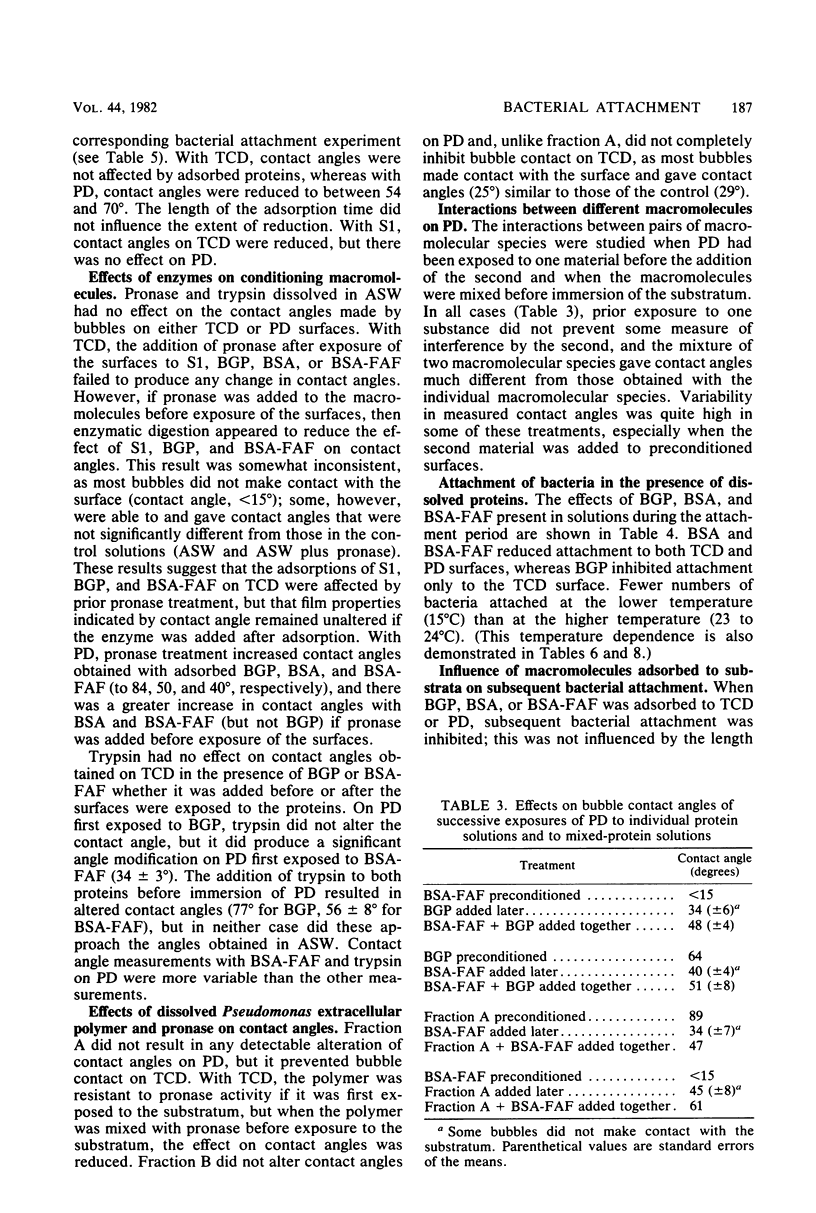Abstract
A bubble contact angle method was used to determine interfacial free-energy characteristics of polystyrene substrata in the presence and absence of potential surface-conditioning proteins (bovine glycoprotein, bovine serum albumin, fatty acid-free bovine serum albumin), a bacterial culture supernatant, and a bacterial exopolymer. Clean petri dish substrata gave a contact angle of 90°, but tissue culture dish substrata were more hydrophilic, giving an angle of 29° or less. Bubble contact angles at the surfaces exposed to the macromolecular solutions varied with the composition and concentration of the solution. Modification by pronase enzymes of the conditioning effect of proteins depended on the nature of both the substratum and the protein, as well as the time of addition of the enzyme relative to the conditioning of the substratum. The effects of dissolved and substratum-adsorbed proteins on the attachment of Pseudomonas sp. strain NCMB 2021 to petri dishes and tissue culture dishes were consistent with changes in bubble contact angles (except when proteins were adsorbed to tissue culture dishes before attachment) as were alterations in protein-induced inhibition of bacterial attachment to petri dishes by treatment with pronase. Differences between the attachment of pseudomonads to petri dishes and tissue culture dishes suggested that different mechanisms of adhesion are involved at the surfaces of these two substrata.
Full text
PDF








Selected References
These references are in PubMed. This may not be the complete list of references from this article.
- Costerton J. W., Geesey G. G., Cheng K. J. How bacteria stick. Sci Am. 1978 Jan;238(1):86–95. doi: 10.1038/scientificamerican0178-86. [DOI] [PubMed] [Google Scholar]
- Dexter S. C., Sullivan J. D., Williams J., Watson S. W. Influence of substrate wettability on the attachment of marine bacteria to various surfaces. Appl Microbiol. 1975 Aug;30(2):298–308. doi: 10.1128/am.30.2.298-308.1975. [DOI] [PMC free article] [PubMed] [Google Scholar]
- Fletcher M., Loeb G. I. Influence of substratum characteristics on the attachment of a marine pseudomonad to solid surfaces. Appl Environ Microbiol. 1979 Jan;37(1):67–72. doi: 10.1128/aem.37.1.67-72.1979. [DOI] [PMC free article] [PubMed] [Google Scholar]
- Fletcher M. The effects of proteins on bacterial attachment to polystyrene. J Gen Microbiol. 1976 Jun;94(2):400–404. doi: 10.1099/00221287-94-2-400. [DOI] [PubMed] [Google Scholar]
- Maroudas N. G. Polymer exclusion, cell adhesion and membrane fusion. Nature. 1975 Apr 24;254(5502):695–696. doi: 10.1038/254695a0. [DOI] [PubMed] [Google Scholar]
- Marshall K. C. Interaction between colloidal montmorillonite and cells of Rhizobium species with different inogenic surfaces. Biochim Biophys Acta. 1968 Feb 1;156(1):179–186. doi: 10.1016/0304-4165(68)90117-7. [DOI] [PubMed] [Google Scholar]


